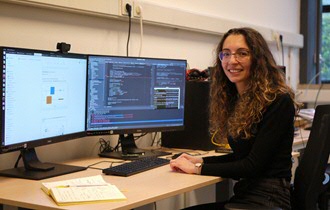Advent calendar - December 8th - Nicoletta Risi
In the Zernike Institute Advent Calendar, we are presenting 24 short spotlights in December. In these specials, we highlight PhD students, postdocs, support staff and technicians of our research groups and team - providing a glimpse in their typical day at work. In Episode 8 meet Dr. Nicoletta Risi , Postdoc in the Bio-inspired Circuits & Systems group of Prof. Elisabetta Chicca.

Within the highly interdisciplinary field of Neuromorphic Engineering and Computing, I am thrilled to contribute as a Postdoctoral Researcher in the Bio- Inspired Circuits and Systems (BICS) group, led by Prof. Elisabetta Chicca. I am Nicoletta Risi and I am a passionate ”neuromorph”. In my research, I am driven by the chance to grasp even a short glimpse of biological computational principles to design adaptive, energy-efficient artificial systems.
Unraveling the blueprint of natural intelligence has always been a fascinating problem. Not only for neuroscientists but also for engineers. Indeed, understanding the underlying mechanisms put in place by biology to optimize energy and computational resources offers an interesting asset from an engineering standpoint. Especially when designing systems that interact with the same environmental conditions faced by biological systems and deal with similar energy-efficiency constraints. Among the unique features of natural intelligence, two are highly remarkable. Firstly, the mixed-signal nature of computation via so-called “action potentials” or “spikes”. Despite being continuous in time, the stereotyped shape of such electrical signals, routed across neurons, offers the reliability of digital communication. Secondly, memory and processing in the nervous system are co-localized at the synapse level which, from an engineering standpoint, reduces the cost of data communication otherwise needed to shift signals between distinct memory and processing units. These, in a nutshell, were the driving insights that in the early ’80s inspired the emerging field of Neuromorphic Engineering to confront the limits of semiconductor technology by getting inspiration from biological neuronal circuits. Today, the term “neuromorphic” has slowly morphed to include a broader spectrum of topics, ranging from conventional hardware platforms that simulate Artificial Neural Networks (ANNs), to Complementary-Metal-Oxide (CMOS) architectures for Spiking Neural Networks (SNNs), as well as novel emerging memory technologies.
In my research, I am interested in understanding how computation emerges from the interplay between biological primitives by emulating them on neuromorphic architectures. This boils down to getting insights from neuroscience findings, emulating computational models on neuromorphic architectures, and eventually embodying such principles onto dedicated artificial systems to explore their potential in a closed-loop environment. In essence, most of my work in the office involves catching up with the latest advancements in the field and fun, sometimes puzzling, hands-on work with neuromorphic sensors and processors. This is usually interleaved with supervising projects and online meetings with external collaborators.
The cross-disciplinary nature of the neuromorphic engineering field is perhaps the biggest challenge in my daily research, and also what makes the puzzle extremely intriguing! Luckily, I am not alone in pursuing this goal. The inspiring, and incredibly fun discussions with my colleagues in the BICS group are an essential component of my research. I find our daily interactions crucial for fostering ideas, solving problems, and ultimately joining efforts to tackle the exciting quest toward neuromorphic intelligence.
One of my favorite activities to reset my mind outside of the office and boost creativity is grabbing my camera and capturing landscapes. As a curious observer, I believe that uncovering and appreciating “details” is fundamental both in art and science, and it is, after all, what drives me the most in my daily research.
Contact: Dr. Nicoletta Risi
| Last modified: | 02 December 2022 10.34 a.m. |
More news
-
24 March 2025
UG 28th in World's Most International Universities 2025 rankings
The University of Groningen has been ranked 28th in the World's Most International Universities 2025 by Times Higher Education. With this, the UG leaves behind institutions such as MIT and Harvard. The 28th place marks an increase of five places: in...
-
05 March 2025
Women in Science
The UG celebrates International Women’s Day with a special photo series: Women in Science.
-
16 December 2024
Jouke de Vries: ‘The University will have to be flexible’
2024 was a festive year for the University of Groningen. In this podcast, Jouke de Vries, the chair of the Executive Board, looks back.
